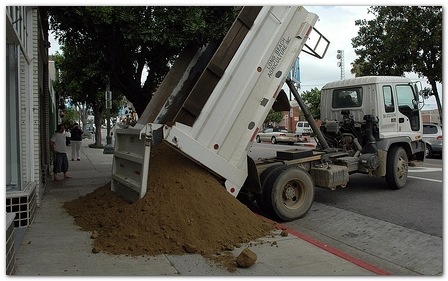CC Photo Credit: by Choctopus on Flickr
Here are even more recently collected links of a Microsoft Windows nature.
Lots of good stuff here.
Sorry about your sidewalk…
Sysinternals Specials
As previously mentioned, all you hard-core Windows desktop support freaks must take some time to watch this awesome TechNet video presentation: "The Case of the Unexplained..."
Hear Mark Russinovich, the master of Windows troubleshooting, walk you through step by step how he has solved seemingly unsolvable system and application problems on Windows. With real case studies, Mark will show how to apply the Microsoft Debugging Tools and his own Sysinternals tools, including Process Explorer, Process Monitor, and Accesschk, to solve system crashes, process hangs, security vulnerabilities, DLL conflicts, permissions problems, registry misconfiguration, network hangs, and file system issues. These tools are used on a daily basis by Microsoft Product Support and have been used effectively to solve a wide variety of desktop and server issues, so being familiar with their operation and application will assist you in dealing with different problems on Windows.
I thought it was well-worth the time I took to watch it.
Want more Mark Russinovich troubleshooting goodness?
The Case of the Random IE and WMP Crashes – Short look on how a video driver caused crashes in Windows Media Player.
The Case of the System Process CPU Spikes – More on Kernrate utility usage and Process Explorer helped Mark to track down a rogue network interface driver.
Pushing the Limits of Windows: Physical Memory - “Pssst. Buddy. Want to see a picture of a system running 64-cores with 2 TB of system RAM?” Then goes into discussion on Windows memory usage and just how much should be enough. Nice technical look.
Autoruns - (freeware) – has gotten some recent version updates to fix some bugs and enhance performance on 64-bit Windows systems.
Windows Mods
6 Things You should Download after Getting Vista - MakeUseOf.com – Light and pleasant selection of “to-do’s” with your new Vista system. I’ve actually done most of these already.
Reinstall Windows and outfit your system with all freeware programs - freewaregenius.com – Quite a selection (sometimes controversial) of freeware programs to add to your Windows system. I have to confess I have quite a few of them already and can vouch for the list choices in general.
Bits from Bill: Windows Update Swaps Dual Monitors – Bill gets hammered by a mis-behaving Windows update. Dual monitors don’t cooperate as expected.
How to customize the new Tools tab that is available in the System Configuration tool (Msconfig.exe) in Windows Vista – Microsoft KB954385
Useful Geek Tricks: Create a Custom System Administration Panel in Windows XP or Vista – How To Geek. Awesomely illustrated tutorial on making a custom Admin Panel in XP or Vista.
CyberNotes: Creating Advanced Desktop Shortcuts in Windows – CyberNet News – Great guide to making some “power-shortcuts” on the desktop. Many advanced Windows users will know this stuff but some progressing newbies might not and could find it helpful.
Key Microsoft File Download Locations
I’m posting these here because I can’t ever remember when to download them from Microsoft and I have a billion bookmarks already in my work machine’s browser.
Windows XP Service Pack 3 Deployment Tools – This is the Sysprep cab file for XP SP3 support.
Windows XP Service Pack 3 Network Installation - This is the download location to get the full XP SP3 installer package.
Office Update: Get additional Office updates – Click this link in IE to run the process to look for Microsoft Office updates.
DiskPart Stuff
In using ImageX to capture and apply images at work and home, part of the process involves prepping the hard-drives before I can put an image back on the system. For this I now turn to DiskPart as part of the WinPE 2.0 boot disk that I use.
Generally it simply comes down to this:
- Boot your target system with your Win PE 2.0 disk.
- Either partition the drive accordingly (if "naked") or format the boot partition.
- Assuming you have the bare-drive ready, create an active partition. In the command-line interface start typing and press <enter> after each line (assuming you don't get any errors.
- Diskpart
- select disk 0
- clean
- create partition primary
- select partition 1
- active
- assign letter = C
- exit
- What we have just done is ran the diskpart utility, selected the master drive (0), cleaned it, created a primary partition on it, selected it, set it to be the active (boot) volume, assigned letter "C" to it, and jumped out.
- Now we just format the active partition that we created above. Type the following and <enter>
- format C: /fs:ntfs /q /y
- Now your drive is formatted with NTFS and ready to go!
However, in there, did you notice the “clean” command?
As we used it here, it simply removed the existing partition/volume formatting information from the in-focus disk by zeroing the sectors for the MBR/GPT and any hidden information on that MDR disk.
However if you use the “clean all” command every single sector on the drive is zeroed out and the data on the drive is deleted. While not quite a fully secure Disk-wiping solution, it is probably effective enough for prepping the system if kept in-house and before issued to another company employee with a new image application.
For more command-line goodness: A Description of the Diskpart Command-Line Utility – Microsoft.
Internet Explorer 8
IE8 and Reliability – IE Blog team.
Looks like IE 8 is going to have some more internal bells-and-whistles for stability control. This post goes into new features such as browser component isolation, automatic crash-recovery for the browser, and improved error reporting.
Processes started are reduced to one at initial launch, and each tab session gets it’s own process to isolate web-sites from each other.
Sounds intriguing.
--Claus

No comments:
Post a Comment